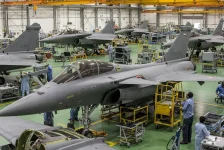- Views: 3K
- Replies: 15
In a significant development for the Multi-Role Fighter Aircraft (MRFA) programme, France has indicated a willingness to move beyond standard "off-the-shelf" solutions, offering to co-develop a bespoke, operationally tailored Rafale fighter for the Indian Air Force (IAF).
However, this deepening strategic partnership faces a critical hurdle: the IAF’s firm demand for access to the aircraft’s proprietary source codes to enable the independent integration of indigenous weapons systems.
A Shift from "Buyer-Seller" to Co-Development
Speaking on the sidelines of a recent bilateral security dialogue in New Delhi, French Ambassador to India Thierry Mathou signalled a pivot in Paris’s approach.He suggested that future Rafale jets manufactured in India would not be mere replicas of those flying for the French Air and Space Force. Instead, they would be "collaborative evolutions," specifically engineered to meet the unique high-altitude and threat-specific requirements of the Indian theatre.
"The Rafale for India won’t be a carbon copy; it will be refined to your skies, your threats, your innovations," Ambassador Mathou stated. This announcement comes as Dassault Aviation negotiates for the Rs 2 lakh crore MRFA contract to supply 114 fighter jets.
The proposal envisions transforming Hindustan Aeronautics Limited’s (HAL) facility in Nashik and the Dassault Reliance Aerospace Limited (DRAL) plant in Nagpur into global hubs for Rafale production by 2030.
The "Black Box" Conundrum
Despite the diplomatic optimism, negotiations have hit a technical bottleneck regarding "software sovereignty." Senior defence officials report that the IAF is aggressively seeking unrestricted access to the Rafale’s Mission Management and Display Computer (MMDC) and Fire Control Computer (FCC).These systems are the digital "brains" of the aircraft, controlling sensor fusion, target tracking, and weapon release
Currently, these units are protected by strict export controls, meaning the IAF must rely on French engineers for any software modifications. This dependency creates a costly logistical hurdle and delays the integration of non-French weaponry.
"Independent access to the MMDC and FCC is the key to true Atmanirbharta," a Ministry of Defence official noted. "It would allow HAL to integrate new weapons in-house, potentially reducing the aircraft's lifecycle costs by 30%."
Indigenous Weapons Integration
The IAF’s demand for open architecture is driven by a desire to equip the Rafale with India’s rapidly maturing arsenal of indigenous missiles.The force aims to integrate the DRDO-developed Astra Mk3, a Beyond Visual Range Air-to-Air Missile (BVRAAM) with a reported range of over 340 km, and the Rudram series of anti-radiation missiles designed for Suppression of Enemy Air Defence (SEAD) missions.
Without source code access, integrating these local systems—or third-party munitions like the Israeli Spice-2000 bombs and the forthcoming BrahMos-NG cruise missile—remains technically difficult and financially prohibitive.
Operational trials have reportedly shown that while the Rafale is exceptional with its native payload, cross-integrating other systems without full software control leads to data-link inefficiencies.
Strategic Context and Future Roadmap
The urgency for this deal is underscored by the IAF’s dwindling squadron strength, which currently stands at approximately 31 squadrons against a sanctioned strength of 42.With regional adversaries fielding advanced stealth platforms like the J-20 and potentially the J-31, the IAF requires a fleet that is not only technologically superior but also adaptable to evolving threats.
Dassault’s proposal to the Defence Acquisition Council (DAC) outlines a comprehensive "Make in India" roadmap. This includes:
- Local Assembly: Leveraging the DRAL facility in Nagpur and a partnership with Tata Advanced Systems Limited (TASL) for fuselage manufacturing.
- Rafale F4.1 Standard: A variant featuring India-Specific Enhancements (ISE), such as upgraded Thales RBE2 AESA radars capable of detection ranges exceeding 250 km, and SPECTRA electronic warfare suites hardened against specific regional jamming threats.
- Future Tech: Potential capabilities for Manned-Unmanned Teaming (MUM-T) with indigenous combat drones like the Ghatak UCAV.
The Path Forward
France’s hesitation to share sensitive source codes stems from intellectual property concerns and international export control obligations under the Wassenaar Arrangement. There is also a strategic anxiety that proprietary technology could leak to rival nations.However, industry analysts suggest a compromise may be on the horizon. Unconfirmed reports indicate a "phased transfer of technology" model could be adopted. This might offer the IAF Tier-1 access for MRFA prototypes by 2027, with full sovereignty over flight control computers granted post-2035, contingent upon achieving 60% indigenous content in manufacturing.
Clarity on the final contours of this deal is expected during the upcoming high-level diplomatic engagements, specifically the "Horizon 2047" roadmap discussions scheduled for Prime Minister Modi’s visit to Paris next July.




